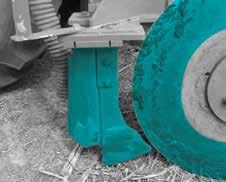
4 minute read
IMPORTANT RSD REMINDER
IMPORTANT RSD REMINDER DELIVERED IN THE HERBERT
More than 40 growers and harvesting contractors have attended preharvest ratoon stunting disease (RSD) workshops in Ingham.
Advertisement
The sessions, jointly delivered by Sugar Research Australia and Herbert Cane Productivity Services Limited (HCPSL), highlighted the key actions that growers and contractors should take to manage the incidence of RSD.
SRA Herbert District Manager Phil Patane said RSD was a significant issue in the Herbert region contributing to losses in productivity and profitability.
“The workshops served to heighten awareness of the disease and to educate growers and contractors to help reduce the number of infected crops, and ultimately increase average yield in the district,” Phil said.
Pathologist Rob Magarey said the advice delivered at the Herbert sessions applied across all districts where RSD had potential to impact yield.
“While RSD shows no external symptoms other than stunting, diseased fields often have an ‘up-and-down’ appearance due to different levels of stunting in adjacent stools,” Rob said.
He said RSD could cause yield losses from 5-60 per cent depending on the susceptibility of the variety and weather conditions. Yield losses are higher when cane is suffering moisture stress.
“Average yield losses are around 15–20 per cent. No sugarcane varieties are resistant to RSD: they can all become infected, suffer yield losses, and further spread the disease,” Rob said. “Recent estimates of losses in the Herbert region suggest that heavily diseased plant crops may suffer losses around 20 per cent, while in diseased ratoon crops, losses around 35 per cent are likely,” he said.
The good news is that it can be managed. “Managing RSD includes planting disease-free seed and minimising transmission to healthy crops by disinfecting planting and harvesting equipment, including cane knives,” Rob said.
Pathologist Rob Magarey speaks to growers in the Herbert.
UNDERSTANDING THE ECONOMICS
RSD can almost be a silent killer when it comes to a profit loss to a farm.
Example Farm
John had a plant source inspection completed on the material he selected to use for planting that year. John’s farm is 150 hectares, and it generally cuts about 85 tonnes cane/ hectare (TCH) across the farm.
Unfortunately, John had one positive RSD sample in his Q253 variety, which yielded less than the rest of the farm, at about 68 TCH.
The estimated yield loss due to RSD infection equates to around 20 per cent. John’s other two blocks of Q253 were RSD-free.
With zero infection in his other blocks, John managed to cut a higher yield of 85 TCH. John sat down with his advisor to calculate his losses at the end of the season (comparing RSD-infected and RSD-free blocks).
He concluded that even though he still received a profit for the infected blocks of about $70 per hectare, he had missed out on an additional $423 per hectare in these blocks because of RSD. This equated to a profit reduction of 85 per cent over his entire farm.
If farm hygiene is not taken seriously, lost revenue will continue to increase year on year as the crop cycle continues and infection increases and spreads further through the blocks.
STEPS TO MANAGE RSD
STEP 1: Fallow management
Fallow periods, in particular volunteerfree fallows, help to break pest and disease cycles.
For managing RSD, it is critical to ensure the fallow is free of volunteer cane to eliminate the disease from the block prior to planting.
STEP 2: Acquiring clean seed material
It is essential that approved seed is planted into fallow ground with no volunteers.
Approved seed includes obtaining material from your local productivity services provider: • from approved clean seed plots • by purchasing tissue culture.
STEP 3: Machinery hygiene
Any equipment which may interact with planting material can spread RSD from an infected source. Therefore, cane knives, harvesters, plant cutters, planters (whole stick and billet) and stool splitters should all be sterilised prior to entering either a clean cane crop from an infected crop or from farm to farm.

UNDERSTANDING MACHINERY HYGIENE
The effect of RSD on cane yield: the image shows a diseased crop (left) compared with a healthy crop (right)
Equipment of concern – Key sterilisation points indicated in BLUE

BILLET PLANTER



WHOLE STICK PLANT CUTTER CANE KNIFE

Sterilising Procedure:
1 Ensure equipment is free of soil and debris. Wash equipment with water prior to sterilising. 2 Use 1 per cent Steri-Max to sterilise equipment thoroughly. Leave equipment to stand for five minutes for the chemical to work effectively. Alternatively, use 30 per cent water and 70 per cent methylated spirits to sterilise equipment. It is not recommended to use methylated spirits where there are potential fire hazards.
3
Steri-Max should be disposed of after 24 hours, once mixed with water. The chemical will de-activate over time.










